How to Support Tomato Plants
This post may contain affiliate links, view our disclosure policy for details.
I’ve tried so many different ways to support tomatoes… This way is the easiest and most successful way that I have come across. Let me share with you how to support tomato plants so your plants can produce a lot of delicious fruit!
There isn’t a vegetable garden without tomatoes, right? The tomato is the queen when it comes to vegetable royalty. If you’ve ever tried a fresh tomato right from the vine you can understand why… There is really nothing like it.
When I started my gardening journey the first vegetable (fruit) that made the list were tomatoes. I could not imagine my garden without them.
I didn’t know much back then, so I bought the tomato plants first, planted them and asked the question later… How am I going to support these tomato plants?
How to Support Tomato Plants…
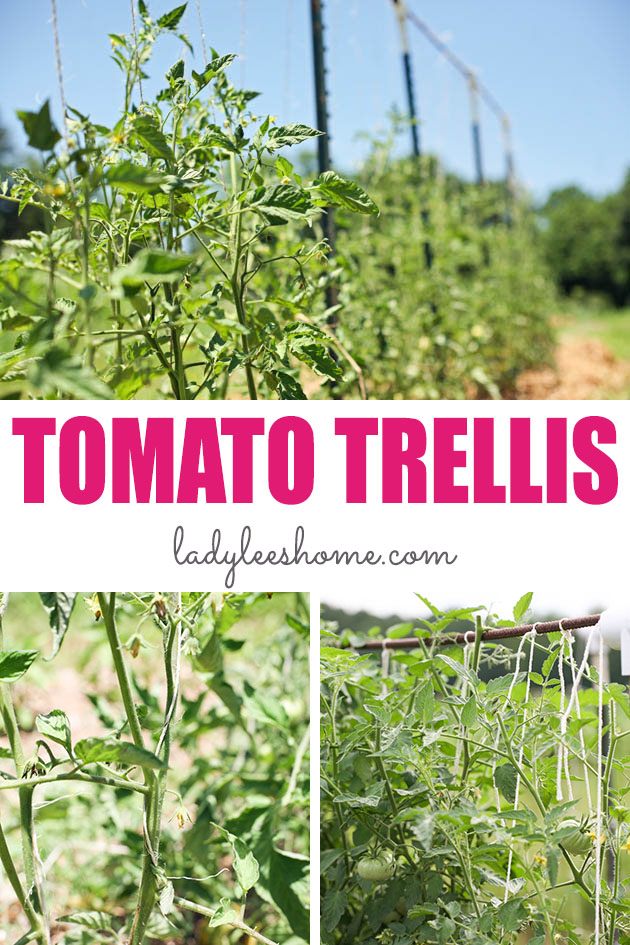
When my plants were a couple of feet tall, I headed to the garden store and bought those flimsy wire tomato cages.
I stuck them in the ground around my tomatoes and called it a day.
A few weeks later the cage could not hold the plant any longer. Part of the reason was that I didn’t prune my tomato plants… They grew to be a giant bush that was indeed very heavy…
But really, the cages themselves were not strong at all.
The few years after that, I tried to hold the cage to the ground with a stake, I tried a different kind of cage (which worked well but there were other issues with it that I’ll share with you below), I tried the Florida weave and a few other ways…
Some of those ways worked ok, but in 2015 when I decided that I was gonna grow vegetables for market and have 100 tomato plants, I knew that I was going to need a better solution.
I’ll tell you all about this solution below but first, let’s start with the basics…
What Kinds of Tomatoes Need Support?
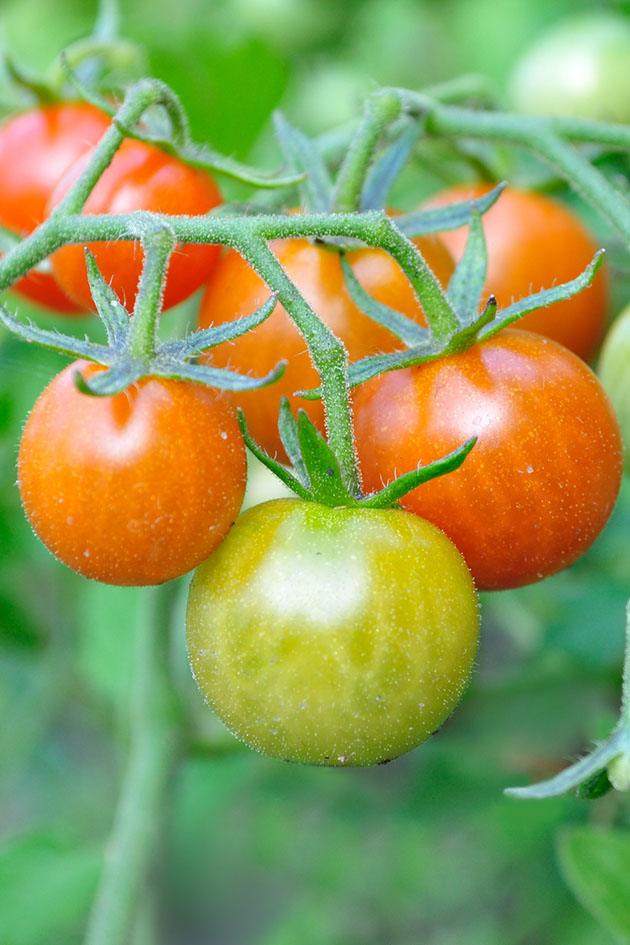
There are two kinds of tomatoes…
Determinate tomato plants are short, they form a bush.
On top of that bush, a cluster of flowers form and stops the growth of the plant upward. Most of the tomatoes on this bush will ripen at approximately the same time. After a couple of pickings the plant will stop producing and can be pulled out of the garden.
Determinate tomatoes are great for processing (here is how to can tomato sauce, how to can crushed tomatoes, and how to can stewed tomatoes). You get most of the fruit you need for preserving at once, can it, and you are done.
Just don’t forget that if you don’t have time to can when the tomatoes are ripe, you can always freeze your tomatoes.
Since the plants are rather short (wider than tall, in other words, bushy) they don’t need a tall cage or a trellis system. They do just fine with a short cage or even tied to a stake.
In fact, on my last trip to Israel, I came by a huge field of determinate tomatoes that did not have any support at all. It was explained that they let them be and don’t stake them so the machine can harvest the field.
In the home garden, I still think that determinate tomatoes will benefit from some support but it can simply be a stake in the ground right next to the plant (you tie the vine to the stake).
Indeterminate tomatoes are viny tomatoes (like Matt’s Wild tomatoes for example). They set fruit clusters along the vining stem all through the growing season until the plants are killed by the first frost.
These tomatoes can be used for canning and cooking but they are mostly grown for slicing (for sandwiches and such) and for salads. As far as preserving them, they are great for fermenting tomatoes.
The plant of an indeterminate tomato grows very tall and will need the support of a tall cage or a trellis system.
In other words, the trellis that I am going to share with you here is for indeterminate tomatoes.
Benefits of Supporting Your Tomato Plants…
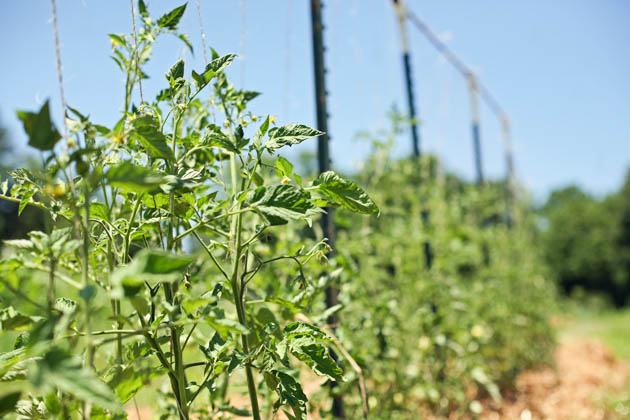
Supporting your tomato plants is important for so many reasons…
Better use of space – you can grow more tomatoes if you grow them vertically. You can plant your tomatoes closer together and really maximize your garden space.
Better airflow – since the tomatoes are growing vertically, and since we are going to prune them, the plants can benefit from much better airflow around them. They are not crowded and the vines don’t grow on top of one another.
Better sun exposure – the same goes for sun exposure… Since the plants are growing vertically and the vines are not in one big pile on the ground, the sun can reach more of the plant.
Better tomato production – when the tomato plant is not stressed, when it’s provided with a proper support system and when the vines are not falling and breaking, the plant can concentrate its energy on producing fruit.
This trellis system that I am going to share with you also encourages you as a gardener to prune your plants which also improves your yield.
In addition, since the fruit is not on the ground you get to keep more of it. When tomatoes touch the soil they tend to rot and become food for insects (you can’t blame the crawlers…). When the plants are supported and the fruit is up on the vine, you have a better chance of keeping it for yourself.
A more organized garden – I don’t know about you, but I am a bit OCD when it comes to my garden… Crawling tomatoes that cover my perfectly organized walkways? No thank you.
Better access – this point is kinda connected to the point above… When my plants are trellised, it’s easy for me to move around them. It’s easier to see what’s going on, treat the plants if I need to, feed the plants, harvest my tomatoes and so on…
Reduce the chance for disease – all the above benefits bring us to the ultimate one… Reducing the chance for disease.
Pests attack weak plants, mold and fungus are created when there is too much humidity and not enough airflow, caterpillars can hide from you better in a pile of leaves than they can in a well-organized plant.
All those reasons and more make it well worth it to take the time to support your tomatoes properly.
Different Ways to Support Tomato Plants…
You’ll find that people get really creative when it comes to supporting tomatoes, especially if they weren’t sure how they were going to support the plant before they planted it.
Tomato vines grow so fast and soon after planting you’ll find that you should start supporting your plant. But many people wait too long and then try to get creative and find a solution in hopes to tame the tomato jungle.
One common way of supporting tomato plants is using cages.
The flimsy wire ones from the store can be used for determinate varieties but I suggest that you don’t use them for indeterminate tomato varieties.
Many people build their own tomato cages from wood and there are a few places to purchase square heavy wire tomato cages.
Some people also use cattle panels or build some kind of wooden structure above their garden bed. You can find some cool ideas in this great post.
Another common way to support tomato plants is called the Florida Weave. You place a stake in the ground every few feet along your tomato bed and then weave a string between the stakes, caging the tomatoes between the string.
I had a few problems with the common options…
- Some of them were too expensive for me… Like buying heavy-duty cages or enough cattle panels.
- Storage was a big issue for me! I didn’t want to have to find room to store tomato cages. From experience I know that they fly in the wind, weeds and grass grow around them, viny weeds climb them… I am a bit OCD and do not like a mess.
- I like to be able to easily move things around if I need to. Many of the structures that I saw where permanent structures installed on garden beds.
- Aside from having a slight case of OCD I am also a minimalist. I like things clean and organized and I also like it if the thing that I invest in can serve multiple purposes. Tomato cages are tomato cages… They might be able to serve as a cage for another kind of plant but their use is limited. I wanted to find a way to set up a multi-purpose trellis.
All those reasons and a few others got me thinking and I started listing all the things that I was looking for in a good tomato support system…
Inspiration From Commercial Growers…
Here is my list… I was looking for a tomato trellis that will be…
Easy to set up and take down – I wanted something that I can move around easily. I also wanted to find a trellis that will be easy to set up for many tomato plants in the field (see, the year that I planted vegetables for the market I did not want to need to buy 100 tomato cages).
Multi-purpose – what if I can find a tomato trellis that will be great as a bean or pea trellis as well? This means that I can rotate more crops in the bed without needing to move or replace the trellis.
Easy to store – I was looking for something that once I take down I can pile in a forgotten corner somewhere and that won’t be an eyesore.
Strong and can support many plants – I didn’t want to have to add anything to support the plants. I wanted to find something that is strong and can carry the weight of many tomato plants.
Affordable – I was looking for a tomato support system made of materials that were not only affordable but that can be of use for me around the homestead for other projects.
So if I buy enough material to support 100 plants and next year I only want to plant 30… I wanted to make sure that I’m using materials that have other uses around the homestead.
I couldn’t find any support system that I liked when I searched for ideas for the home garden so I decided to turn to the professionals.
How do farmers support their many tomato plants in the field?
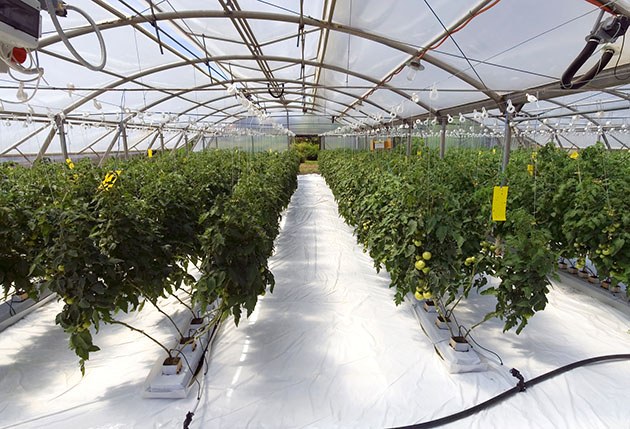
The answer to that question is… They don’t! Most farmers who grow indeterminate tomatoes for commercial production grow the plants in greenhouses.
If you see a field of tomato plants it’s most likely determinate tomatoes for canning (tomato sauce, paste and so on). Those plants are being picked by a machine and there is no trellising material in the way of the machine.
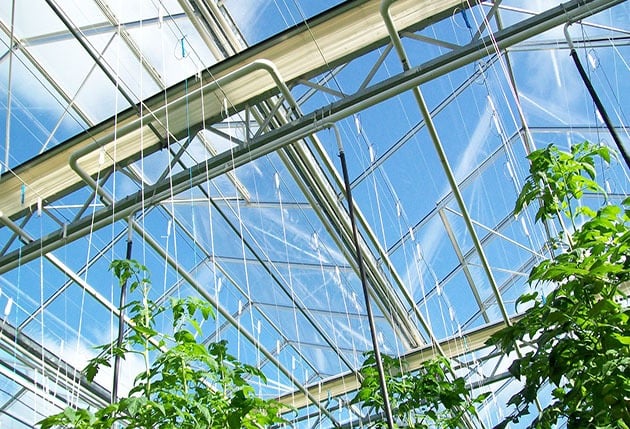
Ok fine… But even if they grow them in a greenhouse, they still need to trellis the plants somehow, right?
Right.
They tie them to the greenhouse structure, that’s how they do it!
Maybe you already knew that but back then, for me, it was a great discovery…
Anyway, I started thinking if there is a way for me to create something similar in the field. I needed some sort of a tall frame that I can tie my tomatoes to and that will also check all the boxes for my other requirements.
Why I Chose This Tomato Trellis…
After a little bit of thinking and a trip or two to the farm supply store and the home improvement store, I came up with a trellis design that is made out of t-posts, rebar, and PVC Tees.
It’s easy to set up and move around, takes very little room to store, and I can use this design to trellis anything from tomatoes to cucumbers to beans and peas.
I can add on to it and if I ever change my mind and don’t want to use this set up anymore there are still plenty of things to do with t-posts around the farm.
It was also very affordable.
I’ve been using this set up for four years and I honestly love it. Let me share this tomato trellis with you…
What We Are Going to Need…
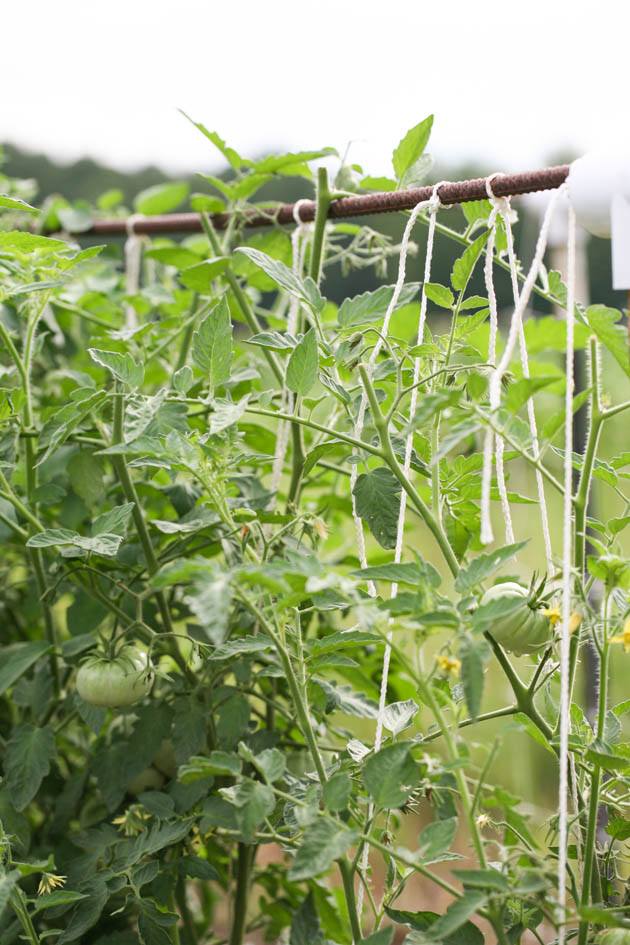
We are going to need a few things…
T-posts – since indeterminate tomatoes can grow to 8′ or even 10′ if you let them, I am using the tall 7′ t-posts.
I think that there are even taller t-posts but I chose the 7′ because I don’t want my plants too tall. I pound the posts 1′ into the ground which means that I am left with 6′ above ground.
Once my plants reach the top I cut them so they stop growing upwards. This allows easy maintenance and directs the energy for the plant to fruit production. More on this later.
The number of posts that you’ll need depends on the number of plants that you are going to support. I bought my t-posts at the local farm supply store.
10′ rebar – the rebar are going to be installed on top of the posts. we will be tying our plants to the rebar.
The number of rebar that you’ll need also depends on the number of plants that you are going to support. I bought my rebar at the local Lowes Home Improvement store.
1 1/4” PVC tees – the tees are going to help us hold the rebar to the t-posts. You’ll need one tee for every t-posts that you are using. I bought my tees at the local Lowes Home Improvement store.
Twine or thin string – I used to use twine to tie my tomatoes. I found that it works pretty well as long as we don’t have a lot of rainy days.
My original thought was that the twine is natural and compostable. I could remove it with the plants at the end of the season and throw it in the compost pile.
This saves me the work of untangling the plants. The second season that I used this design was a very wet season. The sun and rain made the twine weak and I had a few plants that fell to the ground (the twine broke).
Since that season I use a white string that I find at Lowes as well. Even though I have to spend a few extra minutes to untangle the plants from the string at the end of the season it’s worth it. I haven’t lost any plant since I started using the string.
If you have animals that eat hay you can also try using the baling twine. Just save it during the year and use it to tie your tomatoes in the summer.
Tomato clips – I’ll talk more about these later in this post but just wanted to list them here as well.
How to Build a Tomato Trellis…
Building this tomato trellis is super simple…
Before we start, let me just say that I suggest setting this up before you plant your tomato plants. It’s much easier to transplant your tomatoes according to the trellis than it is to build the trellis according to the plants.
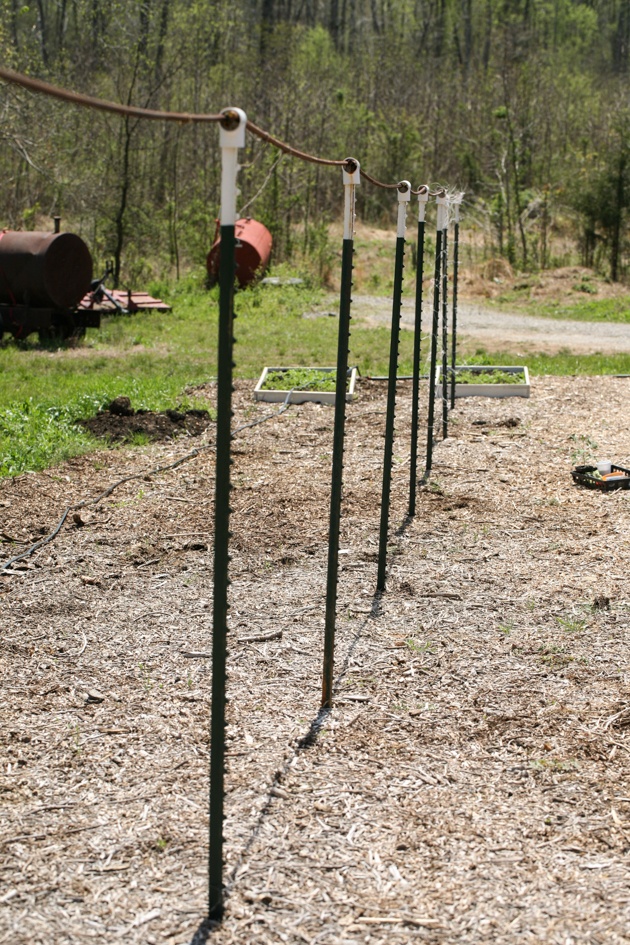
Once you know where your row of tomatoes is going to be, pound the posts 1′ into the ground 4.5′ apart.
Then, on every post, set one PVC tee. Finally, install the rebar through the tees. For every two posts, you’ll use one 10′ rebar.
And… That’s it! Super simple, right?
How to Use This Tomato Support System?
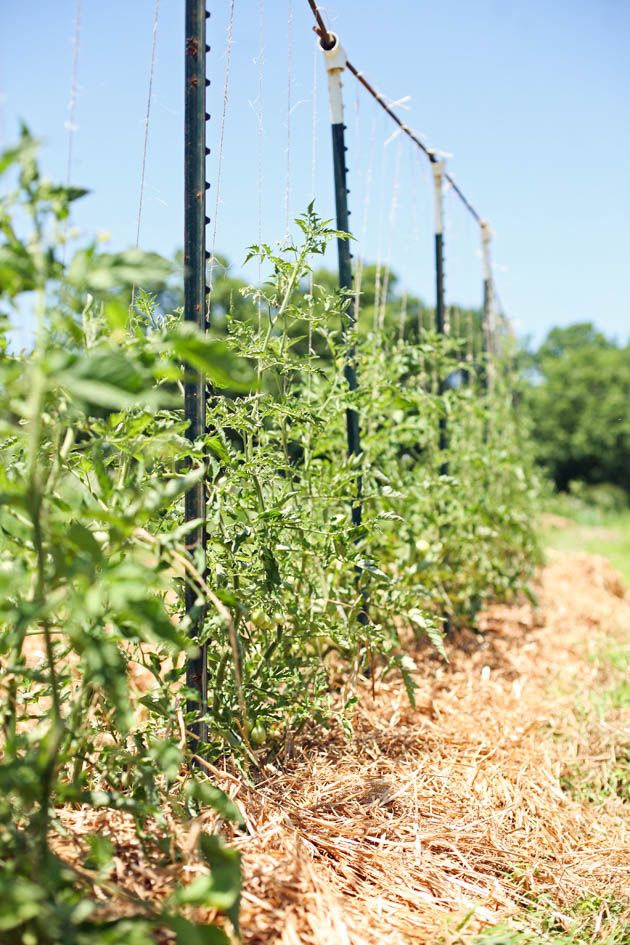
Once you have your trellis installed there is not much to do until your plants are about a foot and a half tall.
Go ahead and plant your tomatoes (here is how and when to transplant tomatoes)…
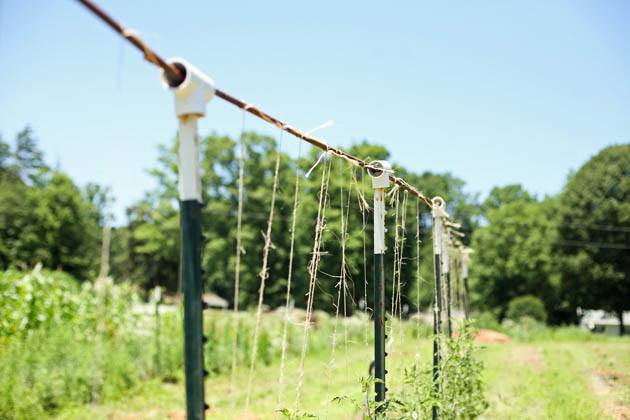
And once the plants are about a foot and a half tall, tie a piece of twine or string to the rebar right above each plant.
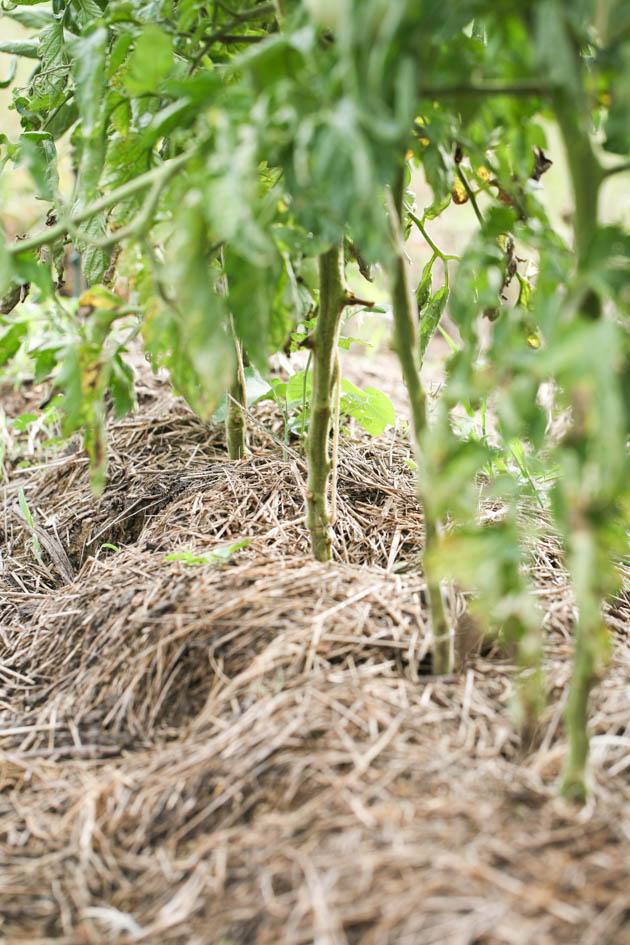
Then, tie (not too tight!) the other end of the string to the stem of the tomato plant underneath it, close to the soil (please see the Improving This Trellis System section below to learn how I do this with the clips now).
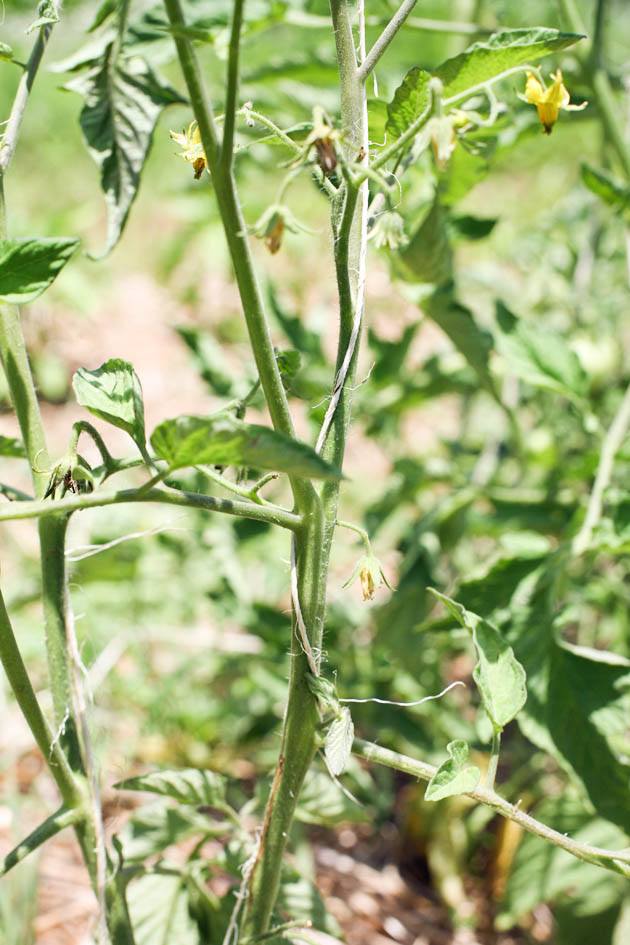
As the tomato plants grow, your maintenance work is to…
- Prune your tomato plant to one or a maximum of two vines.
- Prune all the leaves that are at the bottom of the plant (about a foot off the ground).
- wrap the vine around the string.
- Top off the plants once they reach the rebar.
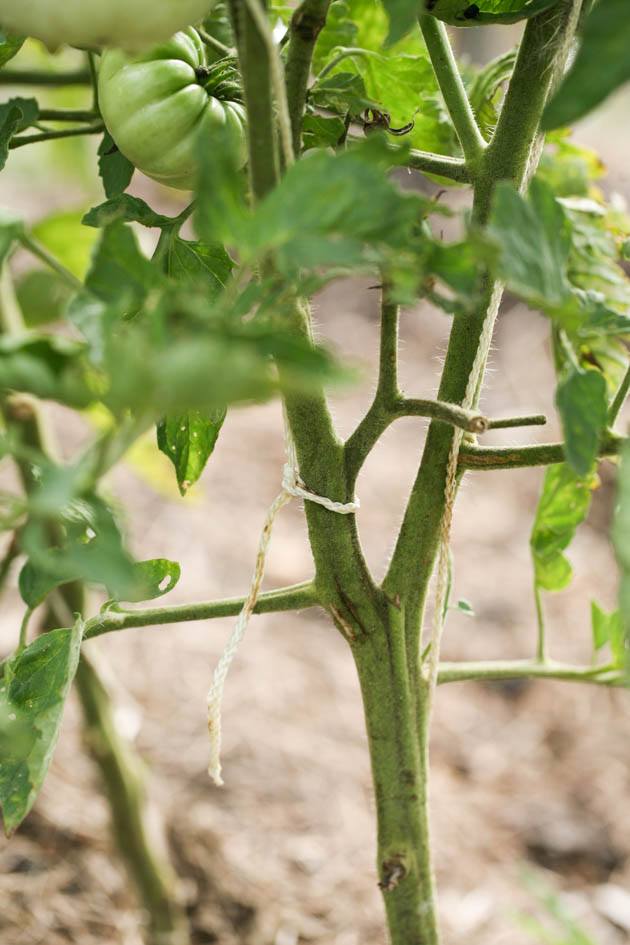
If you decided to allow two vines per plant, you are going to have to tie the second vine to the rebar as well…
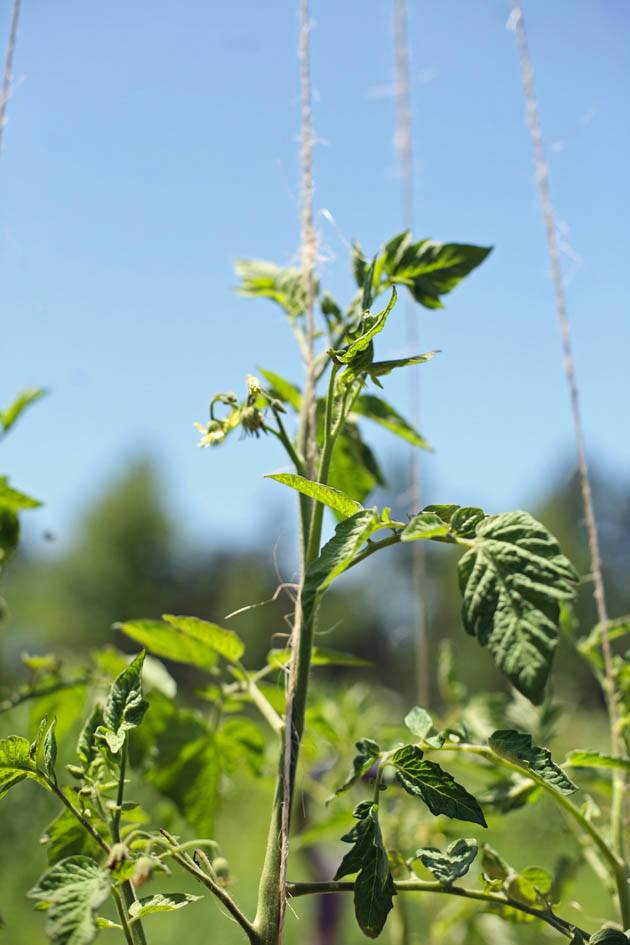
Then, as the vines grow, gently wrap them around the string or twine…
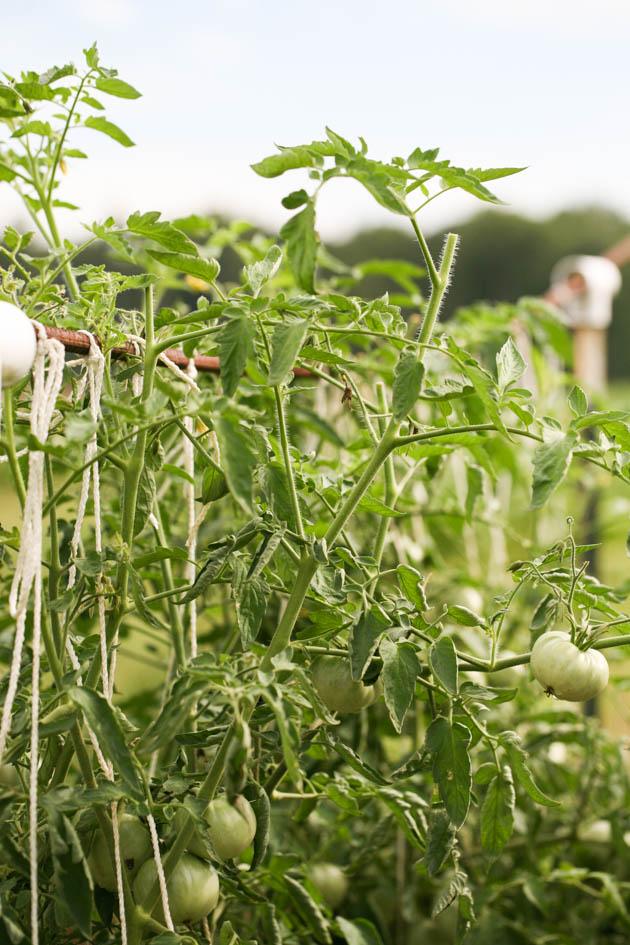
Until they reach the rebar above them. At this point, they are already 6′ tall and I find that it’s tall enough. I top off the plants which simply means clipping the top of the plant when it reaches the rebar.
I show exactly how I do all this in my video about caring for tomato plants.
Improving This Trellis System…
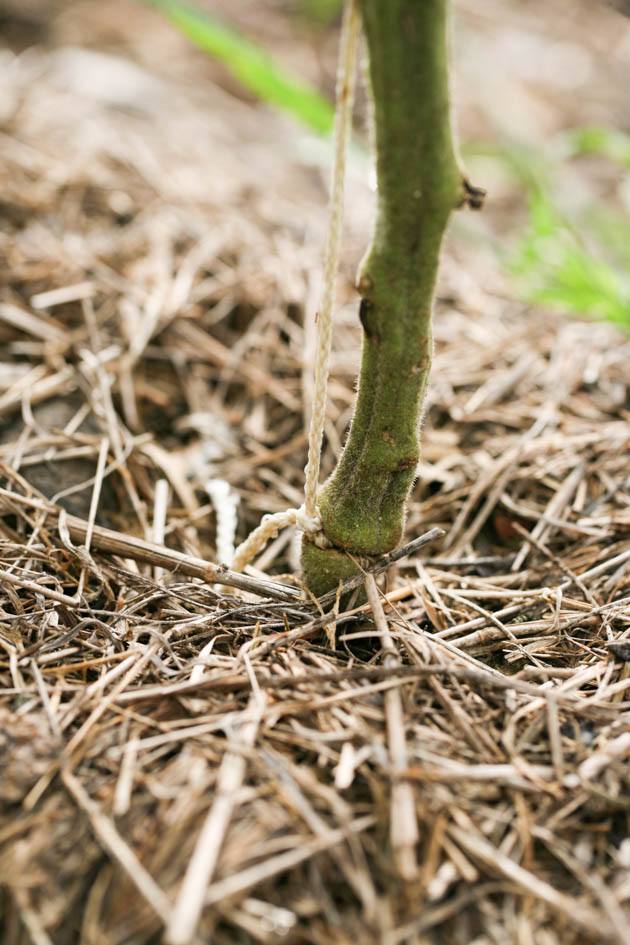
There is one really important thing to pay attention to here. When you tie the tomato plants when they are young, their vine is still thin.
As the plant grows, the vine thickens. If you tied the string too tight when the plant was young it can hurt the vine as it thickens.
It’s really important to make sure that you tie the string loosely when the vine is young and that you check the stem every couple of weeks to make sure it’s not damaged.
If you notice that the tie is too tight, you can try to loosen it a bit or, if you want to prevent this altogether, you can use tomato clips instead of tying to the plants.
You can also use the tomato clips to attach the plant to the string as it grows instead of wrapping the plant around the string.
I buy my tomato clips from Johnny’s Selected Seeds. You can find them here.
Another option is to drive a stake to the ground by every tomato plant and tie the string to the stake instead of to the tomato. This adds a little bit of work but I actually really like this solution because it means that there isn’t anything tied around the base of the plant.
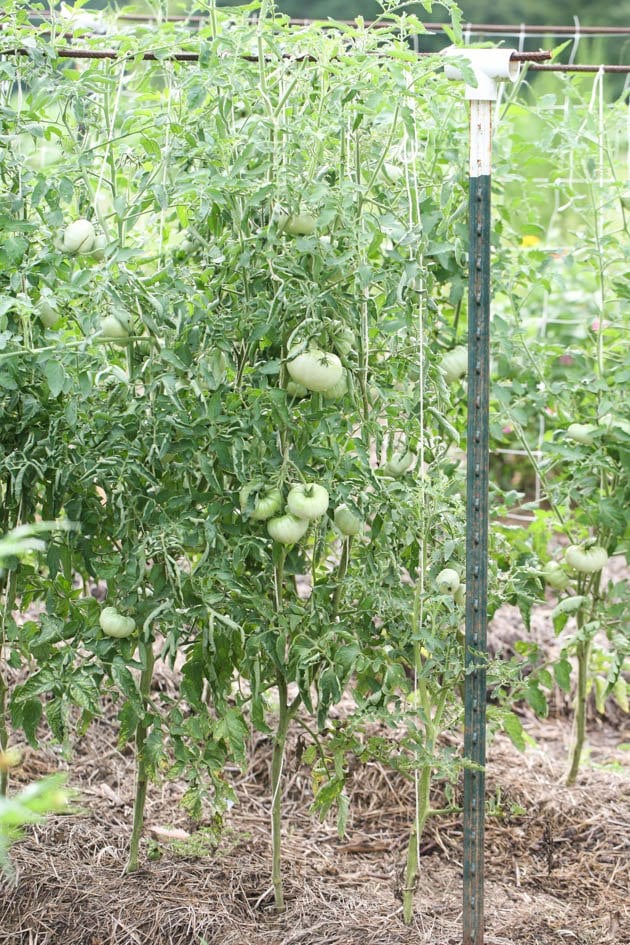
I know that this is a lot of information! But if there is any garden plant that is worth the time of learning how to grow better it’s the tomato.
This trellis is really easy to set up and the materials can survive World War III. T-posts and rebar are not going to break and can serve you for years and years.
I keep this same design and use it to grow anything that needs a trellis. What I do is use zip ties to attach a trellising net to the rebar and t-posts and that’s it.
I make sure the net is a foot from the ground so it’s easy to weed and feed and so on and then I can plant whatever I want that needs trellised in the same row… Beans, butternut squash, cucumbers, peas and so on without needing to build another trellis.
I just have a few rows with the trellis frame already installed and I just switch between the net to the strings according to what I grow in the bed.
I hope this post was helpful and I hope it gave you an idea of how simple it can be to support tomato plants! Let me know what you think in the comments below.
Make sure to check out some of my other gardening posts…
How to Plan a Vegetable Garden
How to Plant and Grow Asparagus
How to Start a Garden Where Grass is Growing
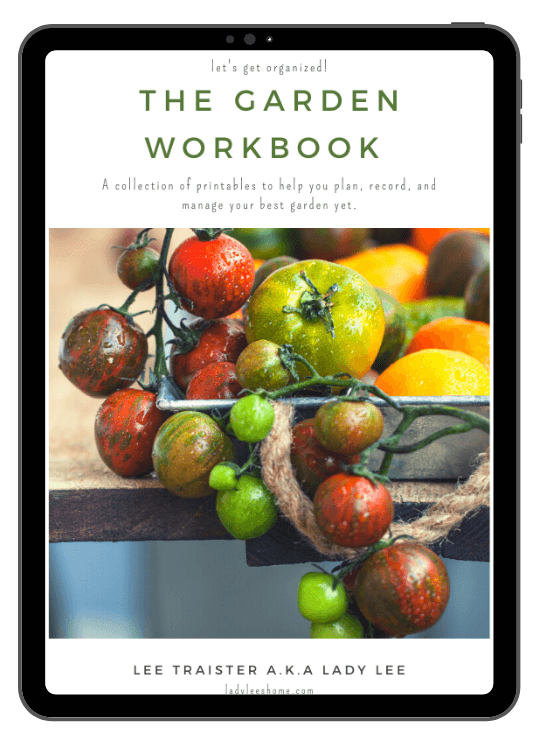
The Garden Workbook is Here!
In part one of this book, we’ll go over how to set up and grow your best garden yet.
Part two consists of 16 garden printables to help you plan, record, and manage your garden properly!

Hi! I’m Lady Lee. I help homesteaders simplify their homesteading journey while still producing a ton of food! I am a single mother of four, I was born in Israel and raised in an agricultural commune called a Kibbutz. Now I homestead in central NC.


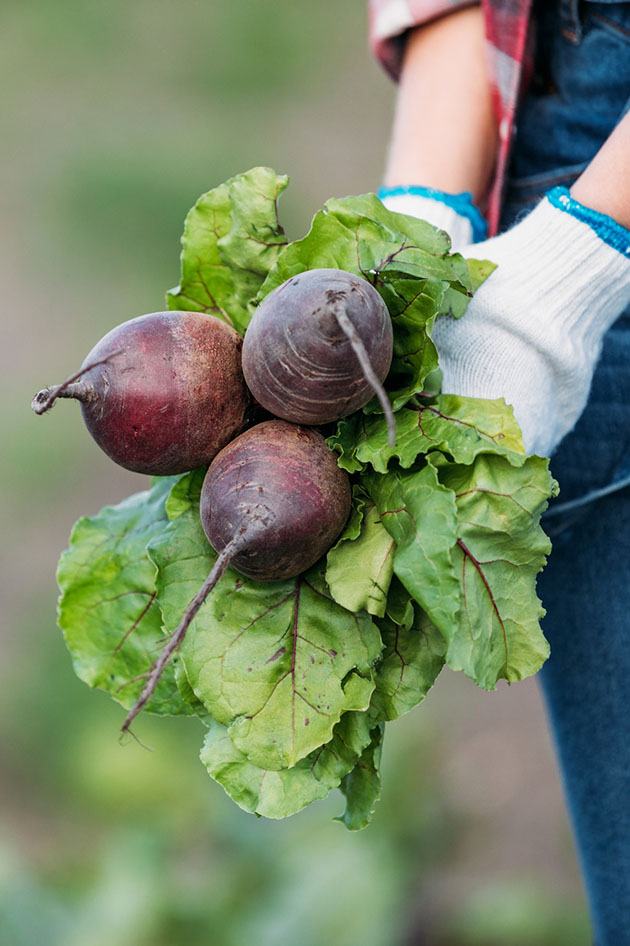
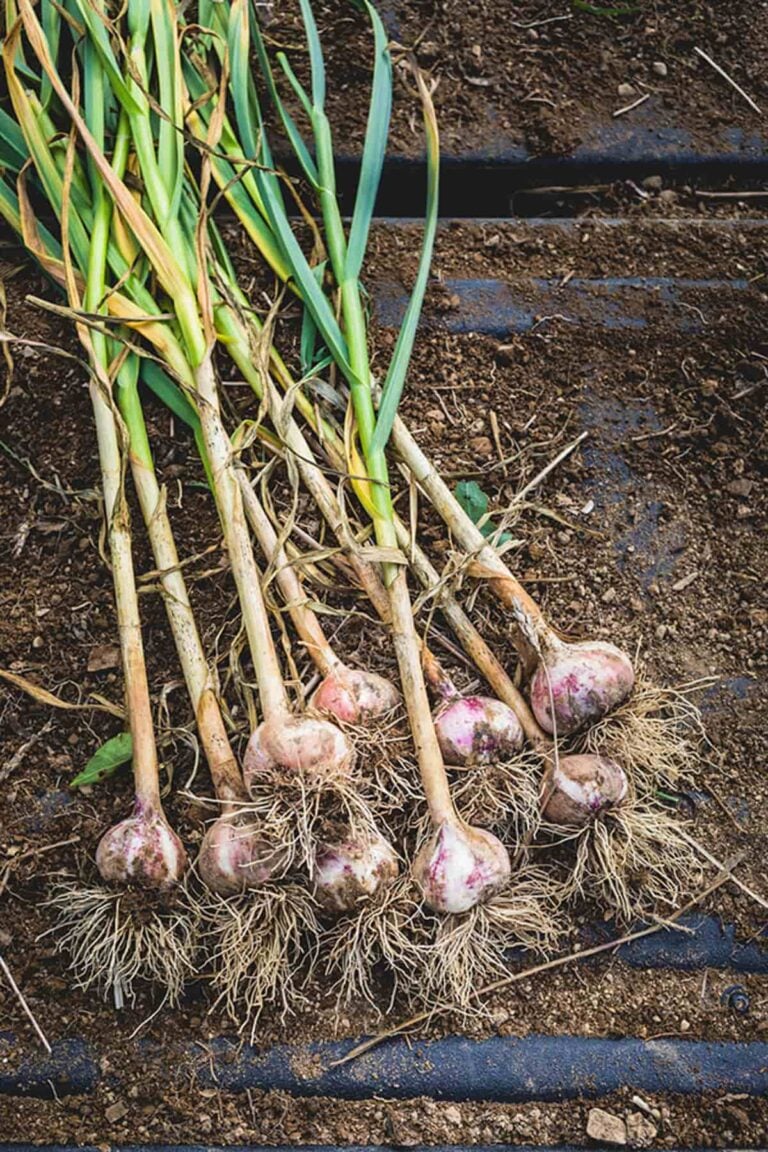
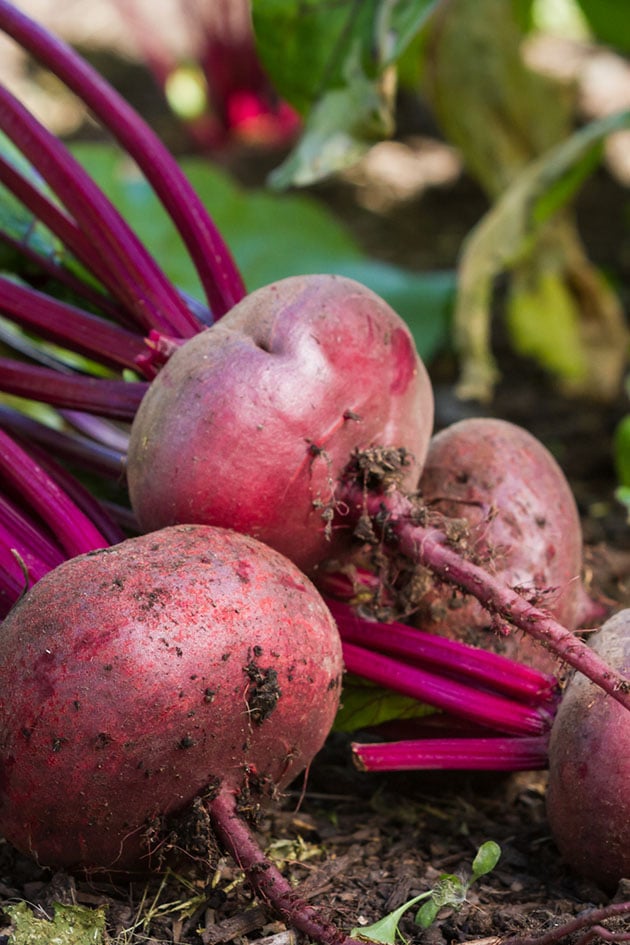
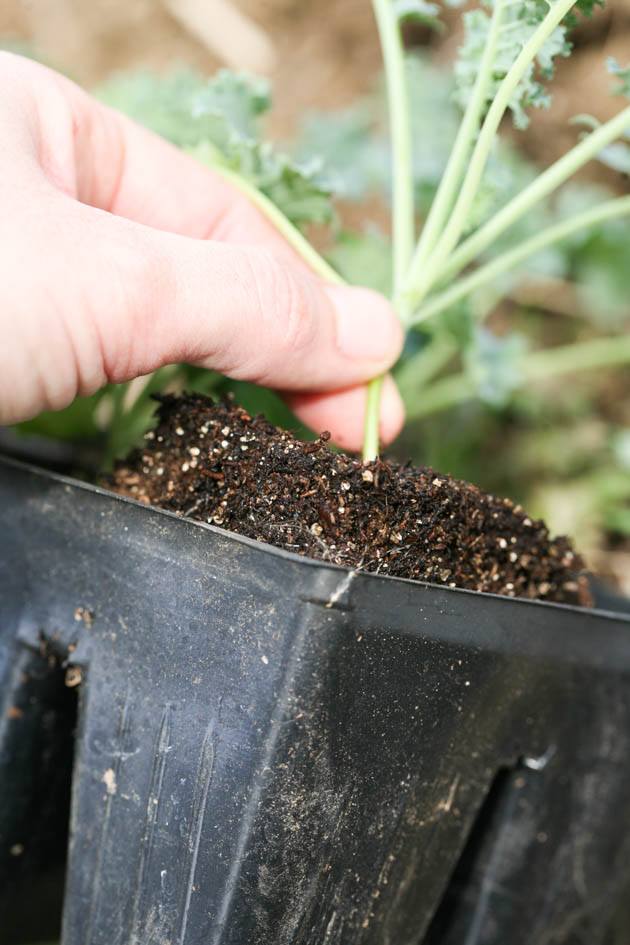
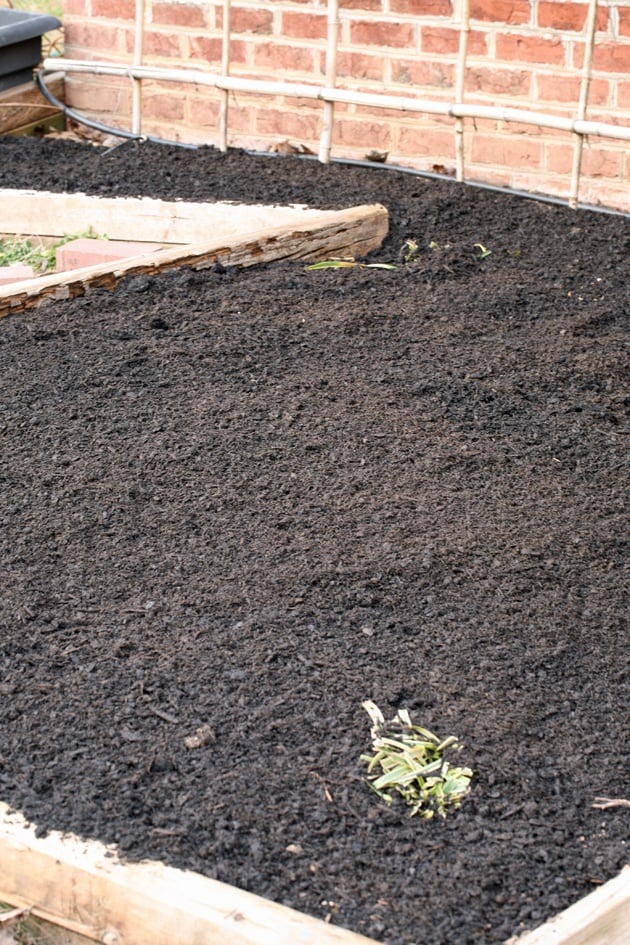
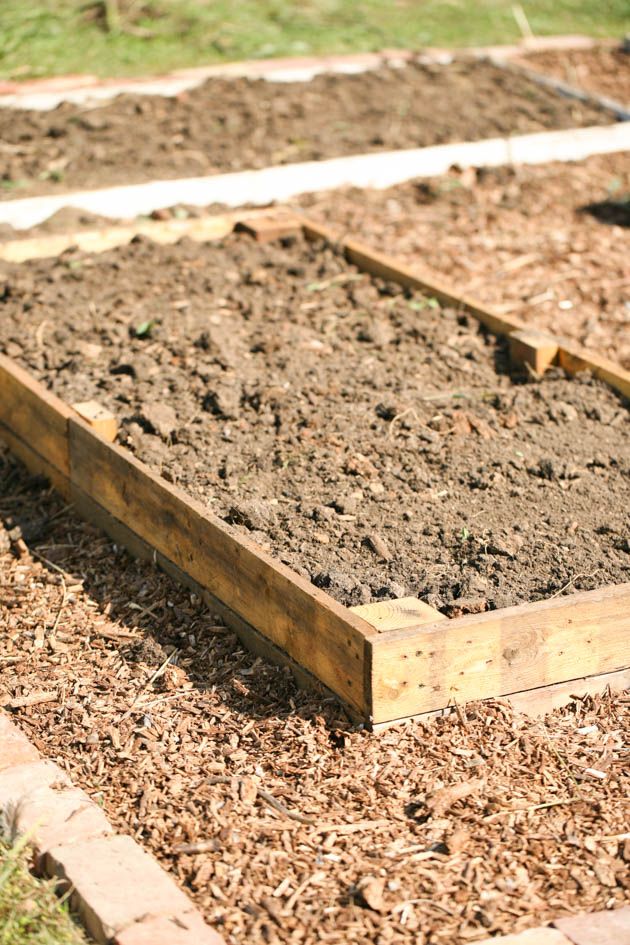
Your post is brilliant! I am VERY late getting my tomatoes in the ground but have most of the materials on hand and now no more sagging strings!!
As long as you keep up with pruning it is, hands down, the best way to support tomatoes in my opinion! Thanks for stopping by, I’m glad you found this helpful and I hope your tomatoes would like it!
you think using rebar for all of it, omitting the T-posts would work just as well?
Rebars instead of the t-posts might be too thin and won’t be able to carry the weight well enough…
Thank you SO much for sharing! I’m in year 6 of gardening and have failed less hard each year at supporting my indeterminate plants and I now feel confident that I’ll actually succeed this year. The PVC and rebar were just the additions I needed for the posts. I’m excited to go shopping tomorrow!
You are welcome! Just remember that you are going to need to prune the plants to one main stem. Other than that, it’s really simple!
Hello, Thank you for these instructions! I have been growing tomatoes for many years and will be trying your plans for supporting my plants this year (should have been done earlier). The plants in the pictures appear to be rather close together. What distance between plants do you recommend? I plant Indeterminate tomatoes 24-36″ apart by 42″ rows. Am I planting them too far apart and wasting real estate? Any thoughts on using a fabric trellis for tomatoes, either in an ‘A’ frame or just straight down? Thank you. I just came upon your site and you have a lot of great information – = Bookmarked
Hi Kenneth, good to have you here! Sorry it took me so long to answer… Summer is crazy!
Anyway, I space my tomato plants 12-18” apart because I prune them. With this system, you kinda have to prune to one main vine (which is supported by the twine). If there is only one main vine and the plant is not huge, there is usually enough air flow and you can plant closer together.
I’ve never used a fabric net trellis for tomatoes… I use it for cucumbers and beans but never for tomatoes so I’m not sure.
Thank you for this post. I just bought my first tomato plant (Matt’s Wild Cherry) and am wondering what the best way would be to stake just the one plant without using a cage.
For just one plant I am not sure about any other option aside from the cages…
Your trellis was a saver for me. I have 10 plants (4 tomatillos and 6 tomatoes) in a 4’x8’ bed. Two rows of five plants. Instead of using rebar I used ½” galvanized conduit for their lighter weight. I also ran conduit along the base on the plants and attached them to the bed frame. So instead of attaching the string to the plant I attach it to the conduit. I think this is the best way to support the tomato plants. Thanks for the idea!
Great improvements! I do need to update this post because, after years of doing this, I also think that it’s much better to attach the plants to something else at the bottom instead of tying the string to them.
Wonderful post. Very good information
Thanks for the feedback!
This is the best way to grow tomatoes. The original idea came from Josh Sattin who has a YouTube channel. I use the original method of using 1/2 conduit pipe as the cross supports. They never rust or sag in the middle like rebar. Plus they are lighter, connectable, and easier to install and store. Never ever tie string to the tomato plant especially at the base. The best method is to just ball up a section of the twine and place it in the bottom of the hole and plant the tomato on top. This will be the most secure method and will not harm the tomato or require re-adjusting as it grows.
Yes! I LOVE Josh! I’ve learned about him years after I came up with this (a friend at the farmer’s market told me about him a couple of years ago) and when I watched some of his older videos I noticed he was doing this. I’ve learned a lot from him since then and the best part is that he is growing literally an hour from me. Finding someone with so much knowledge that is also in the same area as you is a huge bonus!
I should try the conduit. I’ve heard of homesteaders using it to build greenhouses too and other stuff. It sounds like a strong material. I’m still using all of the original equipment that I bought for this trellis back in 2017. I love that it all lasts and I don’t need to repurchase anything!
I am going to use your trellis this year and I have a question about spacing. Usually I plant about 3-4 feet apart. Your photos seem to suggest closer spacing. I intend to plant determinates around the periphery of the bed and the indeterminate under the trellis. My question is – What is the spacing of your plants on the trellis.
I have found this to be a very interesting read. Thanks for that
Pete Fland
I plant 18 inches apart. However, you have to know that if you plant this close you are going to need to prune your plants. I prune my plants to one vine. That vine climbs that twine and I cut its head once it reaches the top of the trellis. If you look up tomato plants on my YouTube channel, you’ll see exactly how I do this.
Excellent post. Thank you!
Glad you liked it! Thanks for stopping by.
I have used this method utilizing leftover string from hay bales. The strings are put in place at the same time as planting, and the end is buried in the soil under the plant, thus avoiding possible problems with tying it to the stem. Works great!
Someone else suggested to me to burry the string as I plant the tomato… I can “see” in my mind how it’s going to be steady enough to hold a whole plant… Does it not come out?? I guess that I just have to give it a try.
I have used landscaping pins. Tie the string to the pin and push into the ground next to the plant. I use the 4 inch ones.
Thank you for this detailed post. I came across the tomato trellis with a whole PVC set up with lots of pipes, tees and elbows but was hesitant to use so much PVC and was trying to find an alternate. This system seems workable to any size/shape and as you said will survive all weather anomalies!
Need help with the following queries –
What diameter of rebar did you use? The PVC tee is pretty roomy with 1 1/4″ dia. Wouldn’t the rebar wobble or does it sit settled with it’s own weight ?
For the last fence post did you do anything like an end cap for the rebar or it just ends with the PVC tee?
Thanks in advance for your reply.
The PVC tee has to be 1 1/4” to fit on top of the T post. Yes, it’s roomy there for the rebar but it’s not moving much for me. It’s heavy so it just lays there somewhere. I can’t remember the diameter of the rebar… maybe 1/4” of an inch? It’s not too thick.
It’s better to make sure that the last rebar doesn’t stick out of the last PVC tee. In my garden right now it sticks out and I keep bumping my head in it. It’s a little bit of a hazard. Another idea, if it has to stock out, is to make a hole in a tennis ball and stick it at the end of the rebar.
I hope that this helps! Thanks for stopping by.